Lancelot
Lancelot du Lac (meaning Lancelot of the Lake, Welsh: Lawnslot y Llyn), also written as Launcelot and other spellings (including early German Lanzelet, early French Lanselos, and early Welsh Lanslod Lak), is one of the Knights of the Round Table in the Arthurian legend where he typically figures as King Arthur's greatest companion and one of his greatest knights. In the best-known tradition, Lancelot is orphaned son of King Ban of Benwick, raised in a fairy realm by the Lady of the Lake. He then becomes the lord of Joyous Gard, and the greatest swordsman and jouster as the knight of most martial prowess of the age – until his adulterous affair with Queen Guinevere is discovered, causing a civil war which is exploited by Mordred and brings about the end of Arthur's kingdom.
| Lancelot | |
|---|---|
| Matter of Britain character | |
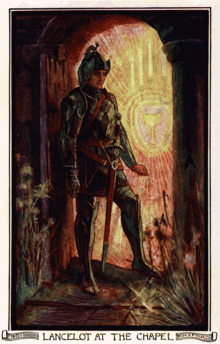 | |
| First appearance | Erec and Enide |
| Created by | Possibly Chrétien de Troyes |
| Based on | Uncertain origins |
| In-universe information | |
| Title | Prince, Sir |
| Occupation | Knight of the Round Table |
| Weapon | Arondight the sword |
| Family | Ban, Elaine of Benoic, Lady of the Lake, Hector de Maris, Lionel, Bors |
| Significant other | Guinevere, Elaine of Corbenic, possibly Galehaut |
| Children | Galahad |
| Origin | Benoic (in today's northern France) |
His first appearance as a main character is found in Chrétien de Troyes' poem Lancelot, the Knight of the Cart, written in the 12th century. Later, his exploits were expanded upon in other works, especially the vast Lancelot-Grail prose cycle that presented the now-familiar version of his legend. There, his and Lady Elaine's son, Galahad, becomes an even more perfect knight and the ultimate achiever of the Holy Grail.
History
Name and origins
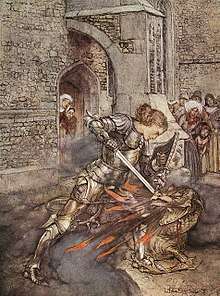
In a theory postulated by Roger Sherman Loomis, Lancelot is related to the characters of Llenlleog (Llenlleawg) the Irishman from Culhwch and Olwen (which associates him with the "headland of Gan(i)on") and the Welsh hero named Llwch Llawwynnauc (probably a version of the euhemerised Irish deity Lugh Lonbemnech, with "Llwch" meaning "Lake" in Welsh), possibly via a now-forgotten epithet like Lamhcalad,[1] suggesting they are the same figure due to the fact that their names are similar and that they both wield a sword and fight for a cauldron in Preiddeu Annwn and in Culhwch. According to more modern scholars like Norma Lorre Goodrich, the name, if not just an invention of the 12th-century French poet Chrétien de Troyes, may have been derived from Geoffrey of Monmouth's character Anguselaus that turned into Anselaus (which in turn was probably a Latinised name of Unguist, a son of the 6th-century Pictish king Forgus) when translated from Geoffrey's Latin into Old French.[2]
Alfred Anscombe proposed that the name came from Germanic *Wlancloth, with roots akin to Old English wlenceo (pride) and loða (cloak),[3] in connection with Vinoviloth, the name of a Gothic chief or tribe mentioned in the Getica (6th century).[4] Other 6th-century candidates for Lancelot's prototype have included French saint Fraimbault de Lassay,[5] a son-in-law of the Anglo-Saxon king Ælle named Wlanc[a],[6] and Maelgwn, king of Gwynedd.[7] Proponents of the Scythian origins of the Arthurian legend speculated that an early form might have been Alanus-à-Lot, that is "Alan of the Lot River",[8] while those looking for clues in the Antiquity see elements of Lancelot in Ancient Greek related mythical figures of Askalos and Mopsus (Moxus).[9]
Lancelot may be also a variant of the name Lancelin,[10] derived from the Old French word L'Ancelot, meaning "Servant" (Lancelot is in fact written this way in several manuscripts).[2] Lancelot or Lancelin may instead have been the hero of an independent folk tale which had contact with and was ultimately absorbed into the Arthurian tradition. The theft of an infant by a water fairy, the appearance of the hero at a tournament on three consecutive days in three different disguises, and the rescue of a queen or princess from an Otherworld prison are all features of a well-known and widespread tale, variants of which are found in numerous examples collected by Theodore Hersart de la Villemarqué in his Barzaz Breiz, by Emmanuel Cosquin in his Contes Lorrains, and by John Francis Campbell in his Tales of the West Highlands.
Early appearances
Lancelot's name appears as third on a list of knights at King Arthur's court in the earliest known work by Chrétien de Troyes, Erec and Enide (1170). The fact that his name follows Gawain and Erec indicates the presumed importance of the knight at court, even though he did not figure prominently in Chrétien's tale. Lancelot reappears in Chrétien's Cligès, in which he takes a more important role as one of the knights that Cligès must overcome in his quest.[1] It is not until Chrétien's poem Lancelot, the Knight of the Cart (Le Chevalier de la Charrette), however, that Lancelot becomes the protagonist. It is also Chrétien who first gives Lancelot the name Lancelot du Lac (Lancelot of the Lake),[11] which was later picked up by the French authors of the Lancelot-Grail and then by Thomas Malory.[12] Chrétien treats Lancelot as if his audience were already familiar with the character's background, yet most of the characteristics and exploits that are today commonly associated with Lancelot are first mentioned here. In the words of Matilda Bruckner, "what existed before Chrétien remains uncertain, but there is no doubt that his version became the starting point for all subsequent tales of Lancelot as the knight whose extraordinary prowess is inextricably linked to his love for Arthur’s Queen."[13]
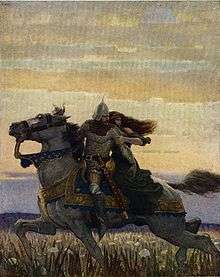
However, Lancelot's passion for Arthur's wife Guinevere is entirely absent from another early work, Lanzelet, a Middle High German epic poem by Ulrich von Zatzikhoven dating from the very end of the 12th century (no earlier than 1194). Ulrich asserts that his poem is a translation from an earlier French work from an unspecified book he had obtained, the provenance of which is given and which must have differed markedly in several points from Chrétien's story. In Lanzelet, the abductor of Ginover (Guinevere) is named as King Valerin, whose name (unlike that of Chrétien's Meliagant) does not appear to derive from the Welsh Melwas. Furthermore, Ginover's rescuer is not Lanzelet, who instead ends up finding happiness in marriage with the fairy princess Iblis. Compared to Chrétien's version, the hero of Ulrich's book is himself Arthur's nephew through his mother (Arthur's sister Queen Clarine), but he too is raised by a water fairy (here the Queen of the Maidenland, having lost his father King Pant of Genewis to a rebellion).[14] It has been suggested that Lancelot was originally the hero of a story independent of the adulterous love triangle and perhaps very similar to Ulrich's version.[15] If this is true, then the motif of adultery might either have been invented by Chrétien for his Chevalier de la Charrette or been present in the (now lost) source provided him by his patroness, Marie de Champagne, a lady well known for her keen interest in matters relating to courtly love.[16]
Evolution of the legend
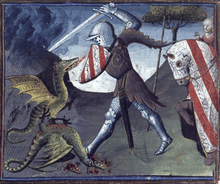
Lancelot's character was significantly further developed during the 13th century in the Old French prose romance Vulgate Cycle, where he appears prominently in the later parts, known as the Prose Lancelot (or Lancelot du Lac) and the Queste del Saint Graal (The Quest for the Holy Grail) respectively. Gaston Paris argued that the Guinevere-Meleagant episode of the Prose Lancelot is an almost literal adaptation of Chrétien's poem, the courtly love theme of which seemed to be forced on the unwilling Chrétien by Marie,[17] though it can be seen as a considerable amplification. Much of the Lancelot material from the Vulgate Cycle has been later removed in the rewriting known as the Post-Vulgate Cycle, with the surviving parts being reworked and attached to the other parts of this cycle. The forbidden love affair between Lancelot and Guinevere can be seen as parallel to that of Tristan and Iseult, with him ultimately identified with the tragedy of chance and human failing that is responsible for the downfall of the Round Table in the later works continuing Chrétien's story.[18]
.jpg)
Lancelot is often tied to the Christian themes within Arthurian legend. Lancelot's quest for Guinevere in Lancelot, the Knight of the Cart is similar to Christ's quest for the human soul.[19] His adventure among the tombs is described in terms that suggest Christ's harrowing of Hell and resurrection: he effortlessly lifts the lid off the sarcophagus, which bears an inscription foretelling his freeing of the captives.[20] Lancelot would later become one of the chief knights associated with the Holy Grail, but Chrétien does not include him at all in his final romance Perceval, le Conte du Graal, the story that introduced the motif into medieval literature. Perceval is the sole seeker of the Grail in Chrétien's treatment; Lancelot's involvement in the Grail Quest is first recorded in the romance Perlesvaus written between 1200 and 1210.[21]
The Middle Dutch so-called Lancelot Compilation (c. 1320) contains seven Arthurian romances, including a new Lancelot one, folded into the three parts of the cycle; the creation of a new romance in the Netherlands indicates Lancelot's widespread popularity even prior to the Lancelot-Grail.[22] In this story, Lanceloet en het hert met het witte voet ("Lancelot and the hart with the white foot"), Lancelot fights seven lions to get the white foot from a hart (deer) which will allow him to marry a princess.[23] Near the end of the 15th century, Malory followed the Lancelot-Grail cycle in presenting Lancelot as the best knight, a departure from the prior English tradition in which Gawain was prominent.[24]
In French prose cycles and Le Morte d'Arthur
Birth and childhood

In the Vulgate Cycle, Lancelot, birth name Galahad (originally written Galaad or Galaaz, not to be confused with his own son of the same name), is born "in the borderland between Gaul and Brittany" as the son of the Gallo-Roman King Ban of Benwick (or Benoic), which is overrun by their Frankish enemy, King Claudas. Ban and his wife Queen Elaine flee the destruction of their final stronghold, carrying the infant child with them. As Elaine is tending to her dying husband, Lancelot is carried off by a fairy enchantress known as the Lady of the Lake, who then raises the child in her magical realm while Elaine becomes a nun. (In an alternate version from the Italian La Tavola Ritonda, the newborn Lancelot is taken when the late Ban's wife Gostanza delivers him two months early and also dies there.)
The child Lancelot grows up and matures much faster than he would naturally do, and it is from this upbringing that he earns the name du Lac – "of the Lake". His double-cousins Lionel and Bors, sons of King Bors of Gaul and Elaine of Benoic's sister Evaine, are first taken by a knight of Claudas and later spirited away to the Lady of the Lake to become Lancelot's junior companions.[25] Lancelotel's other surviving relatives include Bleoberis and his brother Blamore, who both later too join him at the Round Table.
Arthur and Guinevere
_(14580337558).jpg)
Initially known only as the nameless White Knight (Blanc Chevalier), clad in silver steel on a white horse,[26] the young Lancelot arrives in Arthur's kingdom of Logres with the Lady of the Lake to be knighted by the king at her behest. She gives him a powerful magic ring able to dispel any enchantment (as his anonymous fairy foster mother also does in Chrétien's version), and later she and her damsels keep aiding him in various ways through the Vulgate Lancelot. In the Vulgate, the White Knight later takes the name of his grandfather, King Lancelot, upon discovering his identity.[27] In the Post-Vulgate, where Lancelot is no longer the central protagonist, he instead comes to Arthur's court alone and eventually is made a knight after releasing Gawain from enemy captivity, previously also having almost defeated Arthur himself when the king dueled Lancelot without being known (Arthur's magic sword, meant to be used only for the sake of the kingdom and justice, may be broken either in this fight or the one against King Pellinore).
Almost immediately upon his arrival, Lancelot and the young Queen Guinevere fall in love through a strange magical connection between them, and one of his adventures in the prose cycles involves saving her from abduction by Arthur's enemy Maleagant. The exact timing and sequence of events varies from one source to another, and some details are found only in certain sources. The Maleagant episode actually marked the end of the original, non-cyclic version of the Prose Lancelot, telling of only his childhood and early youth, before the later much longer versions.[28] In Malory's Le Morte d'Arthur, the adulterous relationship is postponed for years, as Lancelot's rescue of the Queen from Meleagant (during which, as Malory wrote, "Sir Launcelot wente to bedde with the Quene and toke no force of his hurte honed, but toke his plesaunce and hys lyknge untyll hit was the dawning of the day" after breaking through into her chamber[29]) takes place following the Grail Quest. Nevertheless, just as in Malory's "French book" source, his Lancelot too devotes himself to the service of Guinevere already early in the tale.
Lancelot's knight-errant style initial adventures from the Vulgate Cycle that have been included in Malory's compilation range from proving victorious in a tournament fighting on behalf of King Bagdemagus, slaying the mighty villain Turquine who had been holding several of Arthur's knights prisoner, to overcoming a damsel's betrayal to defend himself unarmed against her husband Phelot. In the adventures exclusive to the Vulgate Lancelot, his further great deeds include slaying multiple dragons and giants. He also plays a decisive role in the war against the Saxons in Lothian (Scotland), when he again rescues Arthur and Gawain (as he does on different occasions) and forces the Saxon witch-princess Camille to surrender. Lancelot dedicates his deeds to his lady Guinevere, acting in her name as her knight. At one point, he goes mad when led to believe that Guinevere doubts his love, until he is found and healed by the Lady of the Lake.[30] Another instance of Lancelot temporarily losing his mind occurs during his brief imprisonment by Camille, after which too he is cured by the Lady. The motif of his recurring fits of madness (especially "in presence of sexually charged women"[31]) and suicidal tendencies (usually relating to the false or real news of the death of either Gawain or Galehaut) returns often through the Vulgate and sometimes also other versions. He also may harbor a darker, more violent side of character that is usually suppressed by the chivalric code but can become easily unleashed during the moments of action.[32]
_(14566092039).jpg)
Eventually, Lancelot wins his own castle in Britain, known as Joyous Gard (a former Dolorous Gard), where he learns his real name and heritage. With the help of King Arthur, Lancelot then defeats Claudas (and his allied Romans in the Vulgate) and recovers his father's kingdom. However, he again decides to remain at Camelot with his cousins Bors and Lionel and his illegitimate half-brother Ector de Maris (Hector). Lancelot, incognito as the Black Knight[33] (on another occasion he disguises himself as the Red Knight as well[33]), also plays a decisive role in a war between Arthur and Galehaut (Galahaut). Galahaut is Arthur's enemy and poised to become the victor, but he is taken by Lancelot's amazing battlefield performance and offers him a boon in return for the privilege of one night's company in the bivouac. Lancelot accepts and uses his boon to demand that Galehaut surrender peacefully to Arthur. At first, Lancelot continues to serve Galehaut in his home country Sorelois, where Guinevere joins him in refuge after Lancelot saves her from the bewitched Arthur during the "False Guinevere" episode.[34] After that, Arthur invites Lancelot to become a member of the Round Table, and Galahaut as well. In spite of this happy outcome, Galahaut is the one who convinces Guinevere that she may return Lancelot's affection, an action that at least partially will result in the fall of Camelot. In the Prose Tristan and its adaptations, including the account in the Post-Vulgate, Lancelot gives refuge to the fugitive lovers Tristan and Iseult as they flee from the evil King Mark of Cornwall.
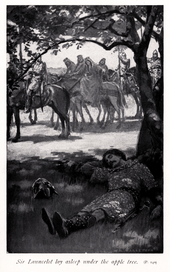
Lancelot becomes one of the most famous Knights of the Round Table (even attested as the best knight in the world in Malory's own episode of Sir Urry of Hungary) and an object of desire by many ladies, beginning with the Lady of Malehaut when he is her captive already early on in the Vulgate Lancelot. Faithful to Queen Guinevere, he refuses the forceful advances of Queen Morgan le Fay, Arthur's enchantress sister. Morgan constantly attempts to seduce Lancelot, whom she at once lustfully loves and hates with the same great intensity. She even kidnaps him repeatedly, once with her coven of fellow magical queens including Sebile. On one occasion (as told in the Prose Lancelot), Morgan agrees to let Lancelot go save Gawain if he will return to her immediately afterwards, and then sets him free on promise that he will not spend any time with either Guinevere or Galehaut for a year; this condition causes Lancelot to go half-mad, and Galehaut to fall sick out of longing for him and eventually to die of anguish after he receives a false rumour of Lancelot's suicide. Another sorceress, named Hellawes, wants him for herself so obsessively that, failing in having him either dead or alive in Malory's chapel perilous episode, she soon herself dies from sorrow. Similarly, Elaine of Astolat (Vulgate's Demoiselle d'Escalot, in modern times better known as "the Lady of Shalott"), also dies of heartbreak due to her unrequited love of Lancelot. On his side, Lancelot himself falls in a mutual but purely platonic love with an avowed-virgin maiden whom Malory calls Amable (unnamed in the Vulgate).
Galahad and the Grail
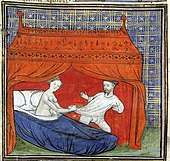
Princess Elaine of Corbenic, daughter of the Fisher King, also falls in love with him; she is more successful than the others. With the help of magic, Elaine tricks Lancelot into believing that she is Guinevere, and he sleeps with her.[35] The ensuing pregnancy results in the birth of his son Galahad, whom Elaine will send off to grow up without father and who later emerges as the Merlin-prophesied Good Knight. But Guinevere learns of that affair and, furious when she finds that Elaine has made Lancelot sleep with her for the second time in Guinevere's own castle, she banishes him from Camelot. Broken by her reaction, Lancelot goes mad again and wanders the wilderness for five years. During this time, he is searched for by the remorseful Guinevere and the others. Eventually, he arrives back at Corbenic where he is recognised by Elaine. Lancelot, shown the Holy Grail through a veil, is cured of his madness, and then chooses to live with her and is known incognito as the Wicked Knight (Chevalier Malfait, the form also used also by Malory). After ten years pass since his recovery, Lancelot is finally found by Perceval and Ector, who have both been sent to look for him by Guinevere.
Upon his at long last return to the court of Camelot, Lancelot takes part in the great Grail Quest. The quest is initiated by Lancelot's estranged son, the young teenage Galahad, having prevailed over his father in a duel during his own dramatic arrival at Camelot, among other acts that proved him as the most perfect knight. Following further adventures, Lancelot himself is allowed only a glimpse of the Grail, because he is an adulterer and furthermore was distracted from the faith in God by earthly honours that have come through his knightly prowess. It is instead his spiritually-pure son who ultimately achieves the Grail. Galahad's also virgin companions, Lancelot's cousin Bors the Younger and King Pellinore's son Perceval, then witness his ascension into the Heaven.
Later years and death
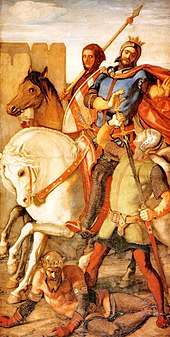
Ultimately, Lancelot's affair with Guinevere is a destructive force, which was glorified and justified in the Vulgate Lancelot but becomes condemned by the time of the Vulgate Queste.[36] After his failure in the Grail quest, Lancelot tries to live a chaste life, angering Guinevere who sends him away, altrough they soon reconcile and resume their relationship as it was before Elaine and Galahad. When Maleagant tries to prove Guinevere's infidelity, he is killed by Lancelot in a trial by combat. Lancelot also saves the Queen from an accusation of murder by poison when he fights as her champion against Mador de la Porte upon his timely return in another episode included in Malory's version. (In all, he fights in five out of the total of eleven such duels taking place through the Prose Lancelot.[37]) But when the truth is finally revealed to Arthur by Morgan, it leads to the death of three of Gawain's brothers (Agravain, Gaheris and Gareth) when Lancelot with his family and followers arrive to violently save Guinevere from being burned at the stake, setting in motion the events leading to the death of Arthur in a version introduced in the Vulgate Mort Artu.
The bloody rescue is followed by a war waged against Lancelot by the vengeful Gawain and Arthur in Britain. With an army, they first besiege Lancelot at Joyous Gard for two months and then pursue him in Gaul (France in Malory). The eventual result of this is the betrayal of Arthur by Mordred, the king's bastard son (and formerly one of Lancelot's young followers), to seize the throne for himself. Meanwhile, Gawain challenges Lancelot to a duel twice; each time Lancelot delays because of Gawain's enchantment that makes him grow stronger between morning and noon, then strikes down Gawain with Galahad's sword but spares his life. However, Gawain's head wound he received nevertheless proves to be fatal later, during the war with Mordred. Upon receiving a desperate letter from the dying Gawain offering him forgiveness and asking for his help in the fight against Mordred, Lancelot hurries to return to Britain, only to hear the news of Arthur's death at Salisbury Plain (that is, in a romance version of the Battle of Camlann). After mourning his comrades, Lancelot's participation in a victorious war against the young sons of Mordred and their Saxon allies provides him a partial atonement for his earlier role in the story.[38] Lancelot personally kills the younger of Mordred's sons after chasing him in a forest in the battle at Winchester, but then goes missing.
There are two main variants of Lancelot's demise, both involving him spending his final years living away from the society as a hermit monk. In the original one from the Vulgate Mort Artu, Lancelot dies of illness four years later while accompanied by only Hector, Bleoberis, and the former Archbishop of Canterbury. It is implied that he wished to be buried beside the king and queen, however he had made a vow some time before to be buried at Joyous Gard next to Galehaut, so he asks to be buried there so as to keep his word. (In the Post-Vulgate, the burial site and bodies of Lancelot and Galehaut are later destroyed by King Mark when he ravages Arthur's former kingdom.)
There is no war with the sons of Mordred in the version included in Le Morte d'Arthur.[20] In it, Guinevere blames all the destruction of the Round Table upon their adulterous relationship, which is the seed of all the dismay that followed, and has became a nun. She refuses to kiss Lancelot one last time, telling him to return to his lands and that he will never see her face again. Instead, Lancelot declares that, if she will take a life of penitence, then so will he.[39] Lancelot retires to a hermitage to seek redemption, with eight of his kin joining him in monastic life, including Hector. As a monk, he later conducts last rites over Guinevere's body (who had become an abbess). As she had declared, he never saw her face again in life: in a dream, he is warned that she is dying; he sets out to visit her, but Guinevere prays that she might die before he arrives, which she does, half an hour before his arrival. After the queen's death, Lancelot and his fellow knights escort her body to be interred beside King Arthur (in the same place where Gawain's skull is kept). The distraught Lancelot's health then begins to fail (in fact, even before this time, Le Morte d'Arthur states that he had lost a cubit of height due to his fastings and prayers). Lancelot dies six weeks after the death of the queen. His eight companions return to France in order to take care of the affairs of their lands after his death. Acting on Lancelot's death-bed request, they go on a crusade to the Holy Land and all die there fighting the Saracens ("Turks" in Malory[40]).
Gallery
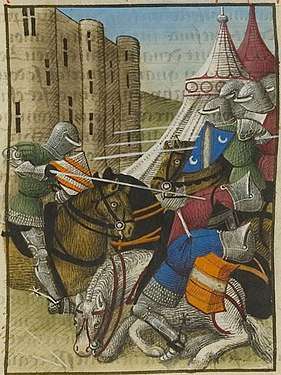 "How Lancelot fought the six knights of Chastel d'Uter to save the knight of the badly-cut coat." (Tristan en prose c. 1479–1480)
"How Lancelot fought the six knights of Chastel d'Uter to save the knight of the badly-cut coat." (Tristan en prose c. 1479–1480) Lancelot, dressed in brown, living with his companions in a hermit hut at the end of his life (Tristan en prose c. 1450–1460)
Lancelot, dressed in brown, living with his companions in a hermit hut at the end of his life (Tristan en prose c. 1450–1460)
- N. C. Wyeth's illustrations from The Boy's King Arthur
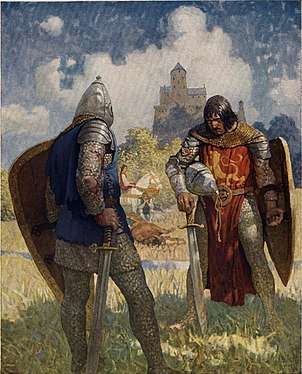 "I am Sir Launcelot du Lake, King Ban's son of Benwick."
"I am Sir Launcelot du Lake, King Ban's son of Benwick." "Sir Mador's spear broke all to pieces, but his spear held."
"Sir Mador's spear broke all to pieces, but his spear held."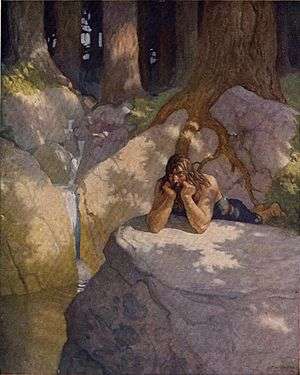 "[Lancelot] ever ran wild wood from place to place"
"[Lancelot] ever ran wild wood from place to place"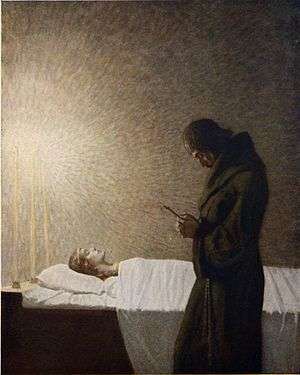 "Launcelot saw her visage, he wept not greatly, but sighed."
"Launcelot saw her visage, he wept not greatly, but sighed."
In modern culture
Lancelot appeared as a character in many Arthurian films and television productions, sometimes even as the protagonistic titular character. He has been played by Robert Taylor in Knights of the Round Table (1953), William Russell in The Adventures of Sir Lancelot (1956–1957), Robert Goulet in Camelot (1960), Cornel Wilde in Sword of Lancelot (1963), Franco Nero in Camelot (1967), Luc Simon in Lancelot du Lac (1974), Nicholas Clay in Excalibur (1981), Richard Gere in First Knight (1995), Jeremy Sheffield in Merlin (1998), Phil Cornwell in King Arthur's Disasters (2005–2006), Thomas Cousseau in Kaamelott (2005–2009), Santiago Cabrera in Merlin (2008–2011), Christopher Tavarez in Avalon High (2010), Sinqua Walls in Once Upon a Time (2012, 2015), Dan Stevens in Night at the Museum: Secret of the Tomb (2014), and Martin McCreadie in Transformers: The Last Knight (2017), among others.
- T. H. White's novel The Once and Future King (1958) portrays Lancelot very differently from his usual image in the legend. Here, Lancelot is immensely ugly and introverted, having difficulty dealing with people.
- Lancelot is played by John Cleese in the Arthurian parody Monty Python and the Holy Grail (1975). He is portrayed as an awkward knight prone to sudden and uncontrolled outbursts of violence in the section "Sir Lancelot the Brave" that shows his misguided rampage to save a princess who turns out to be a prince and who did not really need to be rescued.[41] He is also a principal character in the follow-up musical Spamalot (2005), played by Hank Azaria. In this version, Lancelot is gay and marries Prince Herbert, who is portrayed by Christian Borle.
- In Roger Zelazny's short story "The Last Defender of Camelot" (1979), the magically-immortal Lancelot finally dies helping Morgana save the world from the mad Merlin in the 20th century. He is played by Richard Kiley in a 1986 episode of The Twilight Zone based on the story.
- In Marion Zimmer Bradley's novel The Mists of Avalon (1982), Lancelet is another name of Galahad, and an estranged son of the Lady of the Lake, Viviane. A handsome and great warrior, he is the protagonist Morgaine's cousin and first love interest, himself bisexual and loving both Gwenhwyfar and Arthur. He is played by Michael Vartan in the novel's film adaptation (2001).
- Lancelot is a major character in Bernard Cornwell's The Warlord Chronicles trilogy of novels (1995–1997). This version of Lancelot is presented as a self-serving, narcissistic and cowardly prince of the lost kingdom of Benoic, left by him to be destroyed by Frankish barbarians. To seize the throne of Dumnonia, Lancelot conspires against Arthur with Guinevere, incites a Christian rebellion, and defects to the invading Saxons, ending up being hanged by his own half-brother Galahad and by the narrator Derfel (who had lost his daughter to Lancelot's scheming). Lancelot's glowiing depictions in legend are explained as merely an influence of the stories invented by the bards hired by his mother.
- The 2003 novel Clothar the Frank by Jack Whyte is told from the perspective of Lancelot. It follows his journeys, starting as a young child until his arrival in Camelot and his meeting with Merlyn and Arthur Pendragon.
- Lancelot is played by Ioan Gruffudd in the non-fantasy film King Arthur (2004), in which he is one of Arthur's warriors. He is mortally wounded when he saves the young Guinevere and slays the Saxon chieftain Cynric during the Battle of Badon Hill.
- Jason Griffith portrayed him in the video game Sonic and the Black Knight (2009). Lancelot's appearance is based on Shadow the Hedgehog.
- Lancelot appears in the light novel and its 2011 anime adaptation Fate/Zero as the Servant "Berserker", played by Ryōtarō Okiayu/Kyle Herbert. Lancelot also appears in the mobile game Fate/Grand Order as a Berserker but also as a Saber class Servant.
- Sophie Cookson's character Roxanne "Roxy" Morton in the film Kingsman: The Secret Service (2014) and its sequel uses the code name Lancelot.
- Lancelot is the primary antagonist in the first season of The Librarians (2014), portrayed by both Matt Frewer and Jerry O'Connell. He gained immortality sometime after the fall of Camelot through magic, and has spent centuries seeking to reverse the events that brought about its destruction. As the mysterious Dulaque (a respelling of his name du Lac), he leads the Serpent Brotherhood, a cult that has long opposed the Library's mission to keep magic out of the hands of humans.
- Giles Kristian's novel Lancelot (2018) is an original telling of the Lancelot story.
- The immortal Lancelot Du Lac, voiced by Gareth David-Lloyd, is a co-protagonist of Du Lac & Fey: Dance of Death (2019), an adventure video game set in Victorian London.
- The video game Age of Empires II: The Age of Kings features Lancelot as a paladin.
- Lancelot is the major character in Wizards: Tales of Arcadia.
References
- Bruce, The Arthurian Name Dictionary, p. 305-306.
- Johnson, Flint (14 August 2002). "The British Sources of the Abduction and Grail Romances". University Press of America – via Google Books.
- Alfred Anscombe (1913), "The Name of Sir Lancelot du Lake", The Celtic Review 8(32): 365–366.
- Alfred Anscombe (1913), "Sir Lancelot du Lake and Vinovia", The Celtic Review 9(33): 77–80.
- https://books.google.com/books?id=_p1MAAAAMAAJ&pg=RA1-PA192
- https://books.google.com/books?id=QnDtohOe8-QC&pg=PA248
- https://books.google.com/books?id=1OqdBAAAQBAJ&pg=PT149
- https://books.google.com/books?id=x9v0FaIgEFEC&pg=PA96
- https://books.google.com/books?id=4bZ3HqdHutMC&pg=PA93
- Goulven Péron, "La légende de Lancelot du Lac en Anjou". Les Cahiers du Baugeois, n°92 (March 2012), pp. 55–63, ISSN 0999-6001.
- William Farina, Chretien de Troyes and the Dawn of Arthurian Romance (2010). Page 13: "Strictly speaking, the name Lancelot du Lac ("Lancelot of the Lake") first appears in Chrétien's Arthurian debut, Erec and Enide (line 1674), as a member of the Roundtable."
- Elizabeth Archibald, Anthony Stockwell Garfield Edwards, A Companion to Malory (1996). p. 170: "This is the book of my lord Lancelot du Lac in which all his deeds and chivalric conduct are contained and the coming of the Holy Grail and his quest (which was) made and achieved by the good knights, Galahad."
- Bruckner, Matilda Tomaryn. "Redefining the Center: Verse and Prose Charrette." In A Companion to the Lancelot-Grail Cycle, edited by Carol Dover. Boydell & Brewer 2003, pp. 95–106.
- Schultz, James A. (1991). "Ulrich von Zatzikhoven". In Norris J. Lacy, The New Arthurian Encyclopedia, pp. 481–82. New York: Garland. ISBN 0-8240-4377-4.
- Cooper, Helen (2006). "Lancelot's Wives". Arthuriana. 16 (2): 59–62 – via JSTOR.
- Arthurian Literature in the Middle Ages : A Collaborative History ed. Roger Sherman Loomis, pub. Oxford University Press 1959, special edition for Sandpiper Books Ltd. 2001, ISBN 0 19 811588 1 pp. 436–39 in Essay 33 Hartmann von Aue and his Successors by Hendricus Spaarnay.
- Fulton, Helen (23 November 2011). "A Companion to Arthurian Literature". John Wiley & Sons – via Google Books.
- MacBain, Danielle Morgan (1993). The Tristramization of Malory's Lancelot. English Studies. 74: 57–66.
- Raabe, Pamela (1987). Chretien's Lancelot and the Sublimity of Adultery. Toronto Quarterly. 57: 259–70.
- Pyle, Howard (1993). King Arthur and the Knights of the Round Table. New York City: Waldman Publishing Corporation. p. 238. ISBN 978-0-86611-982-5.
- Joe, Jimmy. "Grail Legends (Perceval's Tradition)". timelessmyths.com. Retrieved 29 May 2018.
- Brandsma, Frank (1998). "Lancelot". In Gerritsen, Willem P.; van Melle, Anthony G.; Guest, Tanis (trans.) (eds.). A Dictionary of Medieval Heroes. Boydell and Brewer. pp. 160–70. ISBN 978-0851153810.
- "Lanceloet en het hert met de witte voet auteur onbekend, vóór 1291, Brabant". www.literatuurgeschiedenis.nl (in Dutch). Retrieved 9 June 2019.
- Radulescu, R. (2004). "‘Now I take uppon me the adventures to seke of holy thynges’: Lancelot and the Crisis of Arthurian Knighthood." In B. Wheeler (Ed.), Arthurian Studies in Honour of P.J.C. Field (pp. 285-296). Boydell & Brewer.
- Lacy, Norris J. (Ed.) (1995). Lancelot–Grail: The Old French Arthurian Vulgate and Post-Vulgate in Translation, Volume 3 of 5. New York: Garland.
- Arthurian Literature XXV. Boydell & Brewer Ltd. 2008. ISBN 9781843841715.
- "Highlights in the Story". www.lancelot-project.pitt.edu. Retrieved 9 June 2019.
- Sunderland, Luke (14 April 2010). "Metaphor, Metonymy and Morality: The Vulgate Cycle". Old French Narrative Cycles: Heroism between Ethics and Morality.
- Archibald, Elizabeth; Edwards, Anthony Stockwell Garfield (1997). A Companion to Malory. Boydell & Brewer Ltd. ISBN 9780859915205.
- "BnF – La légende du roi Arthur". expositions.bnf.fr (in French). Retrieved 7 October 2018.
- Plummer, John F. (1996). "Frenzy and Females: Subject Formation in Opposition to The Other in the Prose "Lancelot"". Arthuriana. 6 (4): 45–51 – via JSTOR.
- Jesmok, Janet (2007). "The Double Life of Malory's Lancelot du Lake". Arthuriana. 17 (4): 81–92 – via JSTOR.
- Bruce, The Arthurian Name Dictionary, p. 200.
- Medievalists.net (17 December 2017). "Will the Real Guinevere Please Stand Up?". Medievalists.net. Retrieved 8 June 2019.
- Mike Ashley, Michael Ashley (2005). The Mammoth Book of King Arthur. Running Press. p. 582. ISBN 978-0-7867-1566-4.
- Dover, A Companion to the Lancelot-Grail Cycle, p. 119.
- King, David S. (2016). "Victories Foretelling Disgrace: Judicial Duels in the Prose Lancelot". South Atlantic Review. 81 (2): 55–71. doi:10.2307/soutatlarevi.81.2.55 – via JSTOR.
- Dover, A Companion to the Lancelot-Grail Cycle, p. 121-122.
- Umland, Samuel J (1996). The Use of Arthurian Legend in Hollywood Film: From Connecticut Yankees to Fisher Kings. Praeger. p. 91. ISBN 978-0-313-29798-4.
- Roland, Meg (2006). "Arthur and the Turks". Arthuriana. 16 (4): 29–42. ISSN 1078-6279. JSTOR 27870787.
- "The Tale of Sir Lancelot". Creative Analytics. 16 November 2015. Retrieved 29 December 2018.
Bibliography
- Bruce, Christopher W (1998). The Arthurian Name Dictionary. Routledge. ISBN 978-0-8153-2865-0.
- Dover, Carol (2003). A Companion to the Lancelot-Grail Cycle. D.S.Brewer. p. 119. ISBN 978-0-85991-783-4.
- Lancelot of the Lake. Introduction Elspeth Kennedy. Translation and notes Corin Corley (Oxford World's Classics).
![]()
External links
| Wikimedia Commons has media related to Lancelot. |
- Lancelot at The Camelot Project
- An English translation of the Prose Lancelot at the Internet Archive
- Lancelot digital exposition at the Bibliothèque nationale de France (in French)